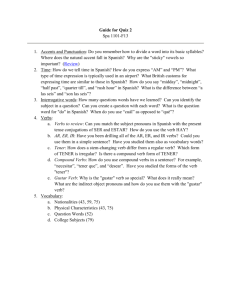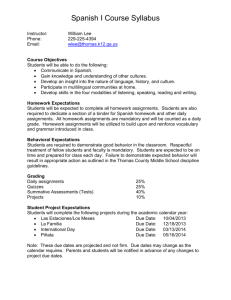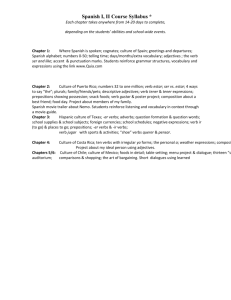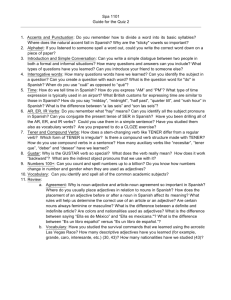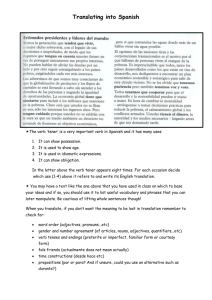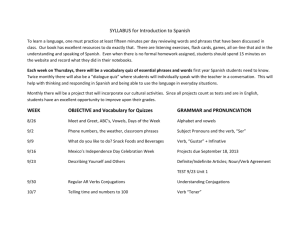Topic - SpanishTechbook
advertisement
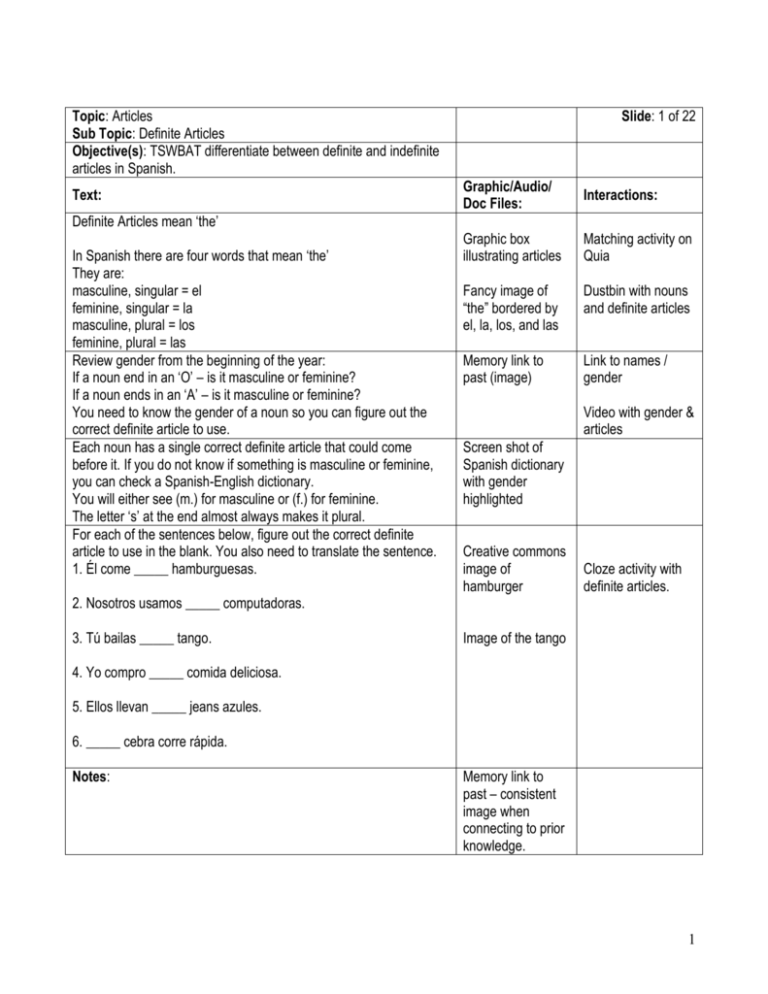
Topic: Articles Sub Topic: Definite Articles Objective(s): TSWBAT differentiate between definite and indefinite articles in Spanish. Text: Slide: 1 of 22 Graphic/Audio/ Doc Files: Interactions: Graphic box illustrating articles Matching activity on Quia Fancy image of “the” bordered by el, la, los, and las Dustbin with nouns and definite articles Memory link to past (image) Link to names / gender Definite Articles mean ‘the’ In Spanish there are four words that mean ‘the’ They are: masculine, singular = el feminine, singular = la masculine, plural = los feminine, plural = las Review gender from the beginning of the year: If a noun end in an ‘O’ – is it masculine or feminine? If a noun ends in an ‘A’ – is it masculine or feminine? You need to know the gender of a noun so you can figure out the correct definite article to use. Each noun has a single correct definite article that could come before it. If you do not know if something is masculine or feminine, you can check a Spanish-English dictionary. You will either see (m.) for masculine or (f.) for feminine. The letter ‘s’ at the end almost always makes it plural. For each of the sentences below, figure out the correct definite article to use in the blank. You also need to translate the sentence. 1. Él come _____ hamburguesas. Video with gender & articles Screen shot of Spanish dictionary with gender highlighted Creative commons image of hamburger Cloze activity with definite articles. 2. Nosotros usamos _____ computadoras. 3. Tú bailas _____ tango. Image of the tango 4. Yo compro _____ comida deliciosa. 5. Ellos llevan _____ jeans azules. 6. _____ cebra corre rápida. Notes: Memory link to past – consistent image when connecting to prior knowledge. 1 Topic: Articles Sub Topic: Indefinite Articles Objective(s): TSWBAT differentiate between definite and indefinite articles in Spanish. Text: Singular indefinite articles mean ‘a’ or ‘an’ Plural indefinite articles mean ‘some’ The indefinite articles in Spanish are: masculine, singular = un feminine, singular = una masculine, plural = unos feminine, plural = unas Each noun has a single correct indefinite article that could come before it. If you do not know if something is masculine or feminine, you can check a Spanish-English dictionary. You will either see (m.) for masculine or (f.) for feminine. The letter ‘s’ at the end almost always makes it plural. You can remember that indefinite articles mean ‘a’ or ‘an’ by comparing it to ‘one’ uno = one una = a When you write, you would use ‘un’ instead of ‘uno’ for a masculine singular noun. For each of the sentences below, figure out the correct indefinite article to use in the blank. You also need to translate the sentence. 1. Ellos viven en _____ casa. Slide: 2 of 22 Graphic/Audio/ Doc Files: Interactions: Fancy ‘a’ bordered by un & una Matching activity on Quia Fancy ‘some’ bordered by unos & unas Dustbin game with nouns & indefinite articles Screen shot of Spanish dictionary with example Flash graphic with uno & una Cloze activity with indefinite articles. 2. La familia come _____ pizza. 3. Yo tengo dos gatos y _____ perro. 4. Ella quiere _____ amigas. 5. Ricardo y Juan son _____ estudiantes. 6. Hay _____ problema* (problema = masculine, singular) Notes: 2 Topic: Articles Sub Topic: Practice Objective(s): TSWBAT select the correct definite or indefinite articles based on the sentence. Slide: 3 of 22 Graphic/Audio/ Doc Files: Text: Interactions: Articles, definite or indefinite, make the sentence complete. Without the articles, either Spanish or English, the sentences do not sound correct. The video is an example of an English conversation missing articles. Can you figure out what is missing? Video – Article Grammarman & the Article Ants It sounds just as silly in Spanish when you are missing the article (or if you use the incorrect article. Choose some practice activities for articles. Each activity is different, so read the directions before you start. Millionaire – Choose correct definite or indefinite article. The prompts will get more challenging each level. Quizlet – Practice with noun and definite/indefinite article pairs. Jeopardy – Write the translated sentence, making sure you use the correct article. Assessment: There is an in-class practice as a formative assessment for using ActivInspire articles. The actual quiz will be the same format, but different Flipchart with sentences. questions programmed Mixed up sentences. You need to put the parts of the sentence in the correct order and add an appropriate article. Check your answers by translating the sentence to make sure it makes sense. 1. 2. 3. 4. 5. Quizbusters with articles & translations Millionaire, Quizlet, & Jeopardy alta / girafa / es Alicia / libros / lee / de Twilight. casa / yo / en / vivo tienen / ellos / amigas tú / shorts / llevas Type 2 Writing: What is the difference between definite and indefinite Collin’s Image articles? Write in English (3 lines, 2 minutes) Notes: Type 1-5 writings are part of the Collin’s writing program. Anything higher than one is a graded response, so it is a form of assessment. The paper & pencil writing Collin’s image will be consistent =Type 2 writing assessment 3 Topic: Clothing Sub Topic: Objective(s): TSWBAT identify the items of clothing in Spanish. Text: Slide: 4 of 22 Graphic/Audio/ Doc Files: Interactions: Vocabulario de Ropa: la blusa ~ blouse la bolsa ~ bag las botas ~ boots el calcetín ~ sock los calcetines ~ socks la camisa ~ shirt la camiseta ~ T-shirt la chaqueta ~ jacket la corbata ~ tie la falda ~ skirt los jeans ~ jeans los vaqueros ~ jeans los pantalones ~ pants el paraguas ~ umbrella la ropa ~ clothes el sombrero ~ hat el suéter ~ sweater el vestido ~ dress el zapato ~ shoe los zapatos ~ shoes PDF of Vocab Interactive Vocabulario 1.2.pdf Slideshow with clothing items Photos of Clothing labeled in Spanish Preguntas ¿De qué color ...? ~ What color ...? ¿Qué lleva? ~ What is he/she wearing? ¿Qué llevas tú? ~ What are you wearing? Links for Vocabulary Practice: Quizlet, StudyStack, Digital Dialects, Quia Online practice links to outside sources Looking at the pictures, answer the questions in a list format using the correct Spanish vocabulary. 1. ¿Qué lleva la chica? 2. ¿Qué lleva Sr. José? 3. ¿Qué llevas tú? Graphic of girl Graphic of señor Graphic of mirror Listening Activity: Draw a stick figure on a piece of paper. Play the description of someone’s outfit, as you hear the outfit described draw it on the stick figure. You will need to use colors too. Notes: See handwritten notes for script for audio activity. Graphic of stick figure Audio File 4 Topic: Clothing Sub Topic: llevar Objective(s): TSWBAT use the correct form of llevar when answer questions about clothing. Text: Slide: 5 of 22 Graphic/Audio/ Doc Files: Interactions: LLEVAR = to wear There are different forms of llevar to show who is wearing. What subject pronouns do you remember? yo, tú, usted, él, ella, nosotros, nosotras, vosotros, ustedes, ellos, ellas Subject pronoun chart with forms of llevar llevar.png The chart shows the correct form of llevar for each of the subject pronouns. Link to Quia – cloze sentence activity Practice using the correct form of llevar on Quia. ¿PREGUNTAS? You need to be able to answer questions with the correct subject and the correct verb. ¿Quién lleva...? ~ Who wears ...? Image question marks Matching activity – definitions of questions/answers and which response goes with the question ¿Qué llevas tú? ~ What do you wear? Yo llevo ... ~ I wear ... ¿Qué lleva ella? ~ What does she wear? Ella lleva ... ~ She wears ...? ¿Qué lleva él? ~ What does he wear? Él lleva ... ~ He wears ... Nosotros llevamos ... ~ We wear ... Ellos llevan ... ~ They wear ... Examples: Los estudiantes llevan uniformes. Ella lleva un vestido. Tú llevas una camisa y los jeans. ¿Qué lleva las personas famosas? Looking at the pictures from different award shows, what are the celebrities wearing? Notes: Graphic with written example Pictures from award shows Voicethread – comments can be added 5 Topic: Clothing Sub Topic: Agreement Objective(s): TSWBAT change the adjective to agree in number and gender with the item of clothing it is describing. Text: Adjectives need to match the gender and the number of the noun they describe. Adjectives that end in –o can have four forms: masculine singular - o feminine singular - a masculine plural - os feminine plural - as The ending of the adjective changes to match the noun. Slide: 6 of 22 Graphic/Audio/ Doc Files: Image of box with adjective endings la ropa image – with article highlighted It does not matter WHO is wearing the clothing, you look at the article of the clothing to find the gender/number of the clothing. image boy wearing dress la ropa (feminine, singular) image multiple people wearing pants el vestido (masculine, singular) even though a boy does not wear a dress. los pantalones (masculine, plural) even though one person wears the pants, the adjective is plural to describe pants. Adjectives that end in –e or any consonants will agree with either a masculine or a feminine noun. To make it plural e + s = - es or consonant + es What adjectives do you know that can be either masculine or feminine? fuerte, trabajador, inteligente, verde, azul Make these adjectives plural: fuertes, trabajadores, inteligentes, verdes, azules ¿Qué llevan los estudiantes? Describe en español the clothing with the color to match each of the items. Type 2 Writing: Describe your outfit in Spanish using adjectives that agree with the clothing. (3 clothing items, 3 minutes) Notes: Interactions: Multiple choice activities to select adjective that agrees: battleship, millionaire, cloze Dustbin with 4 forms of same adjective: Place nouns in correct bin – include non-O or -A nouns. Image of Clothing in color ClothingAgreement .jpg Paper & pencil image The paper & pencil image will be consistent =Type 2 writing 6 Topic: Clothing Sub Topic: Fashion Show Objective(s): TSWBAT write sentences to describe in an outfit using the verb to match the person and adjectives that match the clothing. Text: There is no end of the unit test. Instead we are going to have a Spanish Fashion Show. You will work with a partner to brainstorm a crazy outfit and write descriptive Spanish sentences. Your sentences must use ... the correct form of llevar either definite or indefinite articles and adjectives to describe the clothing You and your partner will add both of your sentences to GoogleDocs. Each student will get their own grade, but you should peer edit. Slide: 7 of 22 Graphic/Audio/ Doc Files: Project description Fashion Show.pdf Interactions: Slideshow with images from previous fashionshows GoogleDoc template for sentences Do not change your partner’s sentences, use ‘ctrl+M’ to leave a comment. You need to share it with your teacher so feedback can be provided ahead of time. FASHION SHOW Today is the big day: our FASHION SHOW Bring the items to class. You will have time to quickly change before we start. Flash – stick figure walking Students will record and photograph the fashion show. Flash - Fashion Show sign flashing Use to create the Voicethread. Voicethread: students will have the ability to add comments. Notes: 7 Topic: AR Verbs Sub Topic: Objective(s): TSWBAT identify the definitions of basic AR verbs. Text: Verbs in Spanish are special. The infinitive form of the verb changes to show who is doing the action. This is called conjugation. Slide: 8 of 22 Graphic/Audio/ Doc Files: Memory link image Interactions: Link to infinitive page and conjugation page Before we get to that step, we need to review the definitions of AR verbs that we have already learned this year. You have many options for practicing the definitions of AR verbs. Choose from the activities below: StudyStack, Quizlet, Battleship, Challenge Board, Millionaire Battleship screenshot When you see the verb in the infinitive, the AR verbs end in AR. The stem of the verb stays the same, only the end changes. Stem/End image verb_stem.png Based on the pictures – write all the AR verbs that could go with the pictures. As a class, we will take the verb lists and write a story. 3 images in a series – writing prompt for a mini story Assessment: Matching quiz with the verbs and the definitions. There will be a pre-test and a post-test for the verb definitions since they were taught at the beginning of the year. Links to outside resources: AR verbs in the infinitive Slideshare – AR verbs in the infinitive with creative commons images Practice quiz on Quia. Notes: 8 Topic: AR Verbs Sub Topic: Infinitive Objective(s): TSWBAT explain the importance of an infinitive verb. Text: Slide: 9 of 22 Graphic/Audio/ Doc Files: Verbs in the infinitive end in ‘R’ Interactions: Slideshare again – verbs in infinitive with creative commons images When the verb ends in ‘R’ it means ‘to … do something’ Examples: Bailar = to dance Pintar = to paint Estudiar = to study Before you conjugate a verb, you need to know what it is in the infinitive. That will make conjugating a lot easier. Link to conjugation page The previous page had many practice activities for verbs defined in the infinitive. Link to AR verbs Are the verbs in the infinitive? ¿Sí o No? 1. salta 2. mira 3. usar 4. pintar 5. cantas 6. hablo 7. patina 8. tocan 9. grito 10. pegar 11. levanter 12. paga 13. llorar 14. buscar 15. da For the ones that you said were not in the infinitive, what do you have to change to make the verb infinitive? Type 2 Writing: Explain the importance or the role of an infinitive verb. Image of questionmarks Collin’s Image Notes: 9 Topic: AR Verbs Sub Topic: Conjugation Objective(s): TSWBAT diagram the steps for conjugating a regular AR verb. Text: Slide: 10 of 22 Graphic/Audio/ Doc Files: Interactions: The verb endings in Spanish change to show how is doing the action. The process of changing the verb is called conjugation. Link to endings & conjugation You need to start with the verb in the infinitive. There are two steps: 1. drop the AR 2. add the correct ending Conjugation PowerPoint STEP 1: Drop, Erase, Make Disappear, Blow Up … the AR STEP 2: Add the correct ending Flash animation SALT AR Drop, erase, disappear, blow up AR HINT: the endings are related to the subject pronouns Memory link image The next page has a complete list of the AR endings. Link to subject pronouns Link to endings Video with subject pronouns/verbs Podcast for AR conjugation. As you listen to the podcast, you are going to fill in a subject pronoun chart. To start, copy down the blank outline of the chart. Subject pronoun chart image Type 4 Writing: Explain conjugation including an example of a verb completely conjugated in the six forms. FCAs: Steps to conjugate, Verb conjugated in 6 forms. The final copy will be a poster – either on paper or digital on Glogster Links to previous student copies of the digital posters: 1. estudiante A 2. estudiante B 3. estudiante C 4. estudiante D Notes: 10 Topic: AR Verbs Sub Topic: Endings Objective(s): TSWBAT compare the relationship between verb endings and subject pronouns. Text: Slide: 11 of 22 Graphic/Audio/ Doc Files: When you conjugate the verb, the ending matches the subject pronoun. Link to conjugation page & subject pronoun page The chart below shows all the AR verb endings with the corresponding subject pronouns. Remember we talked about the dotted line between usted & él / ella as well as ustedes & ellos / ellas. They have the same verb ending, but the definitions of the subject pronouns are very different. The endings also work with mixed subject pronouns. Think about which subject pronouns they match. Subject pronoun and ending chart Chart with mixed subject pronouns Remember the steps to conjugate: 1. Drop the AR 2. Add the correct ending Fill in either the missing subject pronoun or the verb ending based on what is given. 1. ____ gritas fuerte. 2. ____ bailamos. 3. ____ ayudo mi mamá. 4. ____ anda la bicicleta. 5. ____ saltáis. 6. Ella mira___ el televisión. 7. Usted enseñ___ la clase. 8. Nosotros compr____ pizza. 9. Yo us___ la computadora. 10. Ellos jueg____ el béisbol. For additional notes, check out Study Spanish. The next page has recommended and required practice activities for conjugating AR verbs. Quia matching with verb endings & subject pronouns – including mixed Link to Millionaire mixed subject pronoun practice Video by TonitoFrito Music videos with conjugation You can figure out the correct ending by looking at the subject pronoun. You can tell who is doing the action just by looking at the verb ending. An example of a verb conjugated is CAMINAR. Who walks? Check out the chart. Interactions: Subject pronoun chart with CAMINAR conjugated Dustbin with verbs conjugated and subject pronouns Link to StudySpanish Link to practice Notes: 11 Topic: AR Verbs Sub Topic: Practice Objective(s): TSWBAT correctly conjugate a regular AR verb to match the subject pronoun. Text: AR verb conjugation is one of the critical topics of first year Spanish. It is very important that you master conjugations before the end of the year. Slide: 12 of 22 Graphic/Audio/ Doc Files: Interactions: Conjugation Practice – flash animation There is a variety of practice links below to help you master AR conjugations. Some of the games were meant to be played against an opponent. So find a friend, and may the best conjugater win! Spaleon, Quizlet (scatter, space race), StudyStack (matching, bug, hangman, flashcards), Burrito Builder, Study Spanish, Battleship, Challenge Board, More Challenging Screen shots of the Each of the Board, Millionaire games individual games You should keep a practice journal to track the AR practices you complete. Open the GoogleDoc template and ‘Make a Copy’ Save the copy as your last name AR Journal You need to share the Doc with your teacher so you can receive a grade. Class Practice Activities: Digital Dice: Roll both digital dice. The first dice corresponds with the subject. The second dice tells you the verb. Conjugate the verb to match the subject. Table Race: Each table will have a list of subjects and verbs. Work with your table while passing the paper in a circle to conjugate all the verbs. The first table done with all correct wins. Assessment: All students will take the AR conjugation quiz 5 times. The best three scores count as the quiz grade worth 30 points. GoogleDoc icon Link to GoogleDoc template Rolling dice Pdf files for table races Quiz symbol Notes: 12 Topic: AR Verbs Sub Topic: Complete Sentences Objective(s): TSWBAT correctly conjugate a regular AR verb to match the subject pronoun. Text: Slide: 13 of 22 Graphic/Audio/ Doc Files: Interactions: All sentences need a subject and a verb. This is true in both English and Spanish. In Spanish, you have to make sure the verb conjugates to match the subject in the sentence. The subject and the verb is the minimum to write the sentence. You can also add other pieces to the sentence to give it detail. Él come. Él come un taco. Él come un taco grande. Ella nada. Ella nada en el océano. Ella nada en el océano con los tiburones. Image of man eating a big taco. Image of a girl swimming in ocean with sharks Based on the pictures, write sentences in Spanish There are many correct possibilities. If you want to add detail, you can look up individual words using Word Reference. Type 3: Write 5 sentences in Spanish using different subject pronouns. FCA: Each sentence has a subject pronoun and a verb. The verb is conjugated correctly. Audio translations: Write the Spanish sentence you hear. Translate the sentence into English. 1. Nosotros visitamos con la familia. 2. Tú pintas en la clase de arte. 3. Yo cocino con mi mamá y mi tía. 4. Ellos escuchan la música. 5. Raúl usa la computadora. 6. Los estudiantes estudian matemáticas. Notes: Picture prompts for writing Voicethread with pictures Embed Word Reference Collin’s Image Sentences to the left should be recorded/ embedded 13 Topic: Family Sub Topic: Objective(s): TSWBAT identify the Spanish family vocabulary. Text: Family is very important to Spanish culture. Below are the vocabulary words for family. Slide: 14 of 22 Graphic/Audio/ Doc Files: Interactions: Pdf vocabulary list Link to culture Video by TonitoFrito Images of family – arrow shows relationship What is the difference between hermano / hermana or abuelo / abuela? This is another review of gender of nouns. One letter can change the entire meaning of the word. If hermano is brother, what is hermanos? Slideshare with images Framed image labeled ‘abuelos’ Link to gender Framed image labeled ‘hermanos’ with boys & girls Why could it be brothers or siblings? Practice with the vocabulary. Matching, Flashcards, Hangman, Millionaire Brainteasers: Complicated family relationships ¿Quién es? 1. ¿Quién el la madre de la hermana de tu prima? 2. ¿Quién es la abuela del hermano del hijo de tu padre? 3. ¿Quién es el padre de tu tía? 4. ¿Quién es el hermano de la tía del hijo de mi primo? 5. ¿Quién es el nieto de la madre de mi padre? 6. ¿Quién es el hijo de mi abuelo? 7. ¿Quién es la hermana de la tía de la madre de mi hermano? 8. ¿Quién es el hijo del hermano de mi padre? Links to outside resources ActivInspire FlipChart with voting Fake family tree Assessment: Multiple choice definitions of the family vocabulary Notes: Check handwritten notes for fake family tree and questions related to the fake tree. 14 Topic: Family Sub Topic: Personal Objective(s): TSWBAT personalize the vocabulary and articulate who is in their family. Text: Slide: 15 of 22 Graphic/Audio/ Doc Files: Everyone’s family is unique. There are some additional words for us to define: stepfather and stepmother stepbrother and stepsister half brother and half sister Interactions: Embed Word Reference Are there any additional words you need to talk about your own family? After talking to your parents, draw a family tree. Label it with first names and the Spanish word that shows their relationship to you. You can see the example from la familia de Señorita Butler. You will need to be able to answer questions about your family using your family tree. FamilyTree.png Example questions from la familia de Señorita Butler. 1. ¿? 2. ¿? 3. ¿? 4. ¿? ¿? Preguntas ¿? ¿Cómo se llaman tus padres? Mis padres se llaman … ¿Tienes hermanos? Sí/No tengo hermanos ¿Cuántos hermanos tienes? ¿Cuántos años tiene tu hermano/hermana? Él/Ella tiene # años. ¿Cuántos tíos tienes? ¿Cuántos primos tienes? ¿Cuántos hermanos tiene tu madre? ¿Cuántos hijos tiene tu padre? Type 3 Writing: In Spanish, describe your family providing some details such as names or age. FCA: 5 family vocabulary words circled 5 supporting details underlined Verbs are conjugated correctly. Questionmark image Collin’s Image Notes: 15 Topic: Family Sub Topic: Cultural Objective(s): TSWBAT compare the role of family in Spanish speaking countries and the United States. Text: Slide: 16 of 22 Graphic/Audio/ Doc Files: Interactions: What does family mean to you? Family plays an important role in the lives of Spanish speaking people. Authentic article Read the article and watch the video talking about family. Be prepared to compare and contrast to your own family. Video Watch the clip from Plaza Sésamo that describes family. Even from an early age they are taught the importance of family. Video Create a Venn Diagram comparing or contrasting a Spanish family to your own family. Watch the episode of Maya & Miguel and write down all the family vocabulary you hear. The characters speak Spanglish – a mix of Spanish and English. Video – link through PBS Kids “La cocinita” – the Little Kitchen You should see the strong connection between the extended family. Children are raised to have lots of respect for their elders. Notes: 16 Topic: Tener Sub Topic: Irregular Forms Objective(s): TSWBAT identify which forms of tener are irregular. TSWBAT translate tener. Text: Slide: 17 of 22 Graphic/Audio/ Doc Files: Interactions: Tener means to have. In Spanish, there are some special uses for tener – both expressions and expressing obligation. Before we can discuss expressions or tener que, you need to know about the irregular forms. Unlike earlier verbs you learned to conjugate, tener is an ER verb, so the endings are slightly different. Instead of the endings have ‘A’s – the endings have ‘E’s. The yo form is completely irregular. In the tú, usted, él, ella, ustedes, ellos, and ellas forms of the verb, the ‘E’ in the stem changes to ‘IE’ Nosotros and vosotros do not change in the stem. You just have to remember to conjugate the end. Vosotros tenéis que recorder a cambiar el fin. It is easiest to just memorize the forms of tener as vocabulary. The Study Stack link will help you practice. Color coded conjugation chart for tener Video with tener Tener conj.png Study Stack Conjugations & Expressions Notes: There is not enough content for tener to stand alone – so it is going to be combined with tener irregular forms. See handwritten notes for color coded chart with captions 17 Topic: Tener Sub Topic: Expressions Objective(s): TSWBAT translate and use Spanish expressions that use tener. Text: Slide: 18 of 22 Graphic/Audio/ Doc Files: Interactions: Tener is used more frequently in Spanish than ‘to have’ is used in English. Many expressions in English use a form of ‘to be’ are transformed into tener expressions in Spanish. This is a short list of tener expressions that we have used this year: tener # años = to be # years old tener hambre = to be hungry tener sed = to be thirsty tener sueño = to be tired tener calor = to be hot tener frío = to be cold Link to irregular forms of tener You conjugate the verb tener to show who is hungry, or tired, or cold. Based on the prompt, which tener expression would make sense? 1. No come nada en dos días. 2. Celebra mi cumpleaños con mis amigos. 3. Camina en el desierto y no tiene agua. 4. La temperatura hace noventa grados. 5. Quiere ir a la casa y duerme. 6. Es diciembre y hay nieva. desert snow Notes: 18 Topic: Tener Sub Topic: tener + que Objective(s): TSWBAT construct sentences with tener + que to express ‘has to.’ Slide: 19 of 22 Graphic/Audio/ Doc Files: Text: Another use for tener is combining it with ‘que’ to express obligation. TENER + (conjugated to match subject) QUE Interactions: link to tener = TO HAVE TO The verb that follows ‘que’ stays in the infinitive; it should not be conjugated. Example sentences: Nosotros tenemos que estudiar. We have to study. Ella tiene que practicar el piano. She has to practice the piano. Video ‘tener que’ messy bedroom Yo tengo que limpiar mi dormitorio. I have to clean my bedroom. Practice: based on the picture and the subject in parenthesis, write a sentence explaining what each person has to do. Click ANSWERS to check your responses. Link to answers (duplicate hidden page & add answers) Select the correct form of tener. Afterwards, translate each sentence. 1. Yo (tiene / tengo) que comprar un regalo. birthday 2. Mi mamá (tiene / tenemos) que cocinar algo especial. 3. Ronaldo y Luz (tenéis / tienen) que visitar. 4. Nosotros (tienes / tenemos) que celebrar el cumpleaños de mi papá. Type 2 Writing: Write three sentences expressing obligation using tener and different subjects. Collin’s Image Notes: 19 Topic: Subject Pronouns Sub Topic: Objective(s): TSWBAT identify and use subject pronouns in a Spanish sentence. Text: Slide: 20 of 22 Graphic/Audio/ Doc Files: Interactions: Subjects are the people doing the actions or talking. Glogster Main Page – details on subsequent pages Videos on glog Below is a chart of the subject pronouns. Subject pronoun chart Study Stack with subject pronouns The headings for the columns and rows tell you when to use each. Which one is not like the others? VOSOTROS The faded Spanish flag means it is only used in Spain. All other countries use Ustedes for all of you. Practice: Look at each of the images above. Which subject pronoun does the image represent? Compare your answers to the chart: do they make sense? Do any of the pictures have more than one possible answer? Which and Why? Subject Pronoun Practica.png Notes: This page occurs earlier in the course. However, it is referenced multiple times during conjugation, so it needs to be completed for the project. This is like 11B in the sequence of the storyboard. 20 Topic: Adjectives Sub Topic: Objective(s): TSWBAT identify the correct form of an adjective to match a person or object. Text: Adjectives for People: aburrido – boring alto – tall antipático – mean bajo – short bonito – pretty bueno – good cómico – funny Etc Adjectives for objects: pequeño – small grande – big largo – long corto - short rojo – red anaranjado – orange amarillo – yellow verde – green azul – blue violeta – purple rosado – pink negro – black blanco - white The adjectives have to agree in number and in gender with the noun they are describing: masculine vs feminine, singular vs plural Generally adding an ‘S’ makes it plural. (or ‘ES’ if the adjective ends in a consonant instead of a vowel). Slide: 21 of 22 Graphic/Audio/ Doc Files: Adjectivos.pdf Slideshow of images with Spanish adjectives Color Song Video Color activity FlipChart for Promethean board Interactions: ¿Cómo es? Slideshare with characters StudyStack adjectives + ser Color Activity Digital Dialects ¿Qué color no es correcto? Dustbin game Millionaire game Generally an ‘O’ is a masculine ending and ‘A’ is the feminine ending. Adjectives that end in other letters can be masculine or feminine. Notes: This page occurs earlier in the course. However, it is referenced multiple times during the clothing section, so it needs to be completed for the project. 21 Topic: Ser Sub Topic: Objective(s): TSWBAT identify the correct form of ser to match the subject pronoun. Text: Think about English – when you are describing someone you do not say “she to be tall” , “we to be students”, “I to be rich” How would you describe these people in English? She is tall. We are students. I am rich. In Spanish, each subject pronoun has a form of ser that matches. Check out the chart to see the matches. You must use the form of ser that is in the box with the subject pronoun. Vosotros soy bonitos = Y’all am pretty. This sounds just as crazy in Spanish as in English. Tú eres loco ... NOT tú es loco. You can tell the correct form of ser based on the subject pronoun. You can also figure out the subject pronoun based on the form of ser. For the practice activity – figure out what would go in the blank. 1. ____ soy inteligente. 2. Señor Pepe ____ profesor. 3. Usted ____ rica. 4. ____ eres guapo. 5. Andres y Diego ____ locos. 6. ____ somos de Pennsylvania. 7. Ella ____ alta. 8. Nosotros ____ estudiantes buenos. 9. _____ sois de España. 10. Yo ____ especial. The quiz for ser and subject pronouns is very similar to this activity. Based on the information, you need to either fill in the correct subject pronoun or the correct form of ser. Ser + de explains origin of someone. It is where they were born/grew up. It is not necessarily where they live now. Do you remember which countries speak Spanish? Check out the geography section. Notes: This page occurs earlier in the course. Slide: 22 of 22 Graphic/Audio/ Doc Files: Ser.pdf Ser Chart.png Interactions: What is missing from the chart? crazy image Flipchart with self guided questions Scrolling text bar with the answers money caption: You are rich Spain flag caption: Y’all are from Spain. De dónde eres? Map Geography practice worksheet.pdf 22
